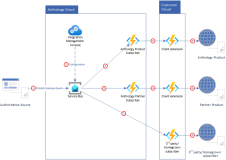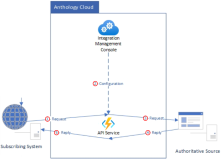Azure Service Bus & APIs
The main objective of Anthology's integration architecture is to separate release-specific code for Anthology products and client-specific extension code from the integration functions so that integrations continue to function when product code or extension code is updated.
The integration architecture can be described based on two models: asynchronous and synchronous.
Asynchronous Integration Using Azure Service Bus
The asynchronous model is a "publish-subscribe" model wherein an Anthology source product publishes business events to the Azure Service Bus and any system attached to the customer's cloud can subscribe to the events. This is basically a one-way message flow, i.e., the source system does not expect a response from the target systems.
Anthology's roadmap includes expanding its product integration capabilities using the Azure Service Bus.
Azure Service Bus is a fully managed enterprise message broker with message queues and publish-subscribe topics (in a namespace). Service Bus is used to decouple applications and services from each other, providing the following benefits:
-
Load-balancing work across competing workers
-
Safely routing and transferring data and control across service and application boundaries
-
Coordinating transactional work that requires a high-degree of reliability
-
The authoritative source publishes a business event to the Service Bus.
-
The Service Bus uses configuration information from the Integration Management Console to validate subscribers.
-
Anthology product or partner functions retrieve messages from the Service Bus and process business logic.
-
Anthology product functions pass messages to client extension functions for client-specific business logic.
-
Messages are published to the subscribing system.
Synchronous Integration Using APIs
The synchronous model introduces an API Service that handles incoming and outgoing messages between the source and target systems. The API Service responds to requests from the subscribing systems. Based on the configuration in the Integration Management Console, the API Service identifies the authoritative source and determines which subscribing system is to receive the reply.
Anthology APIs are published securely for internal and external developers.
-
The subscribing system sends API requests to the API Service.
-
The API Service uses configuration information from Integration Management Console to find the authoritative source.
-
The API Service sends API requests to the authoritative source.
-
Responses are passed back to the API Service.
-
The API Service receives responses and sends them to the subscribing system.

